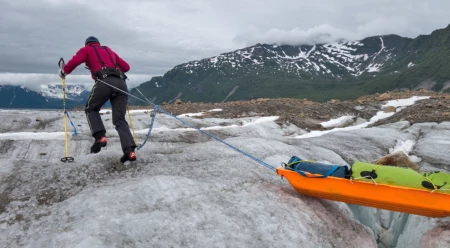Crossing a Glacier in Wrangell–St. Elias National Park on Skis
Experiencing places myself is the ultimate chance for imprinting the reality of them in my mind. Living for a year on a remote atoll in the Pacific allowed me to witness the seawater level rising and its consequences. Yet picturing what’s happening far across the world remains abstract for me. That’s why I wanted to explore the retreating gigantic glaciers. Although I’d heard firsthand stories of them from my boyfriend, Vincent, it still surprised me that venturing into their habitat and experiencing them with my own senses made their voice so loud.
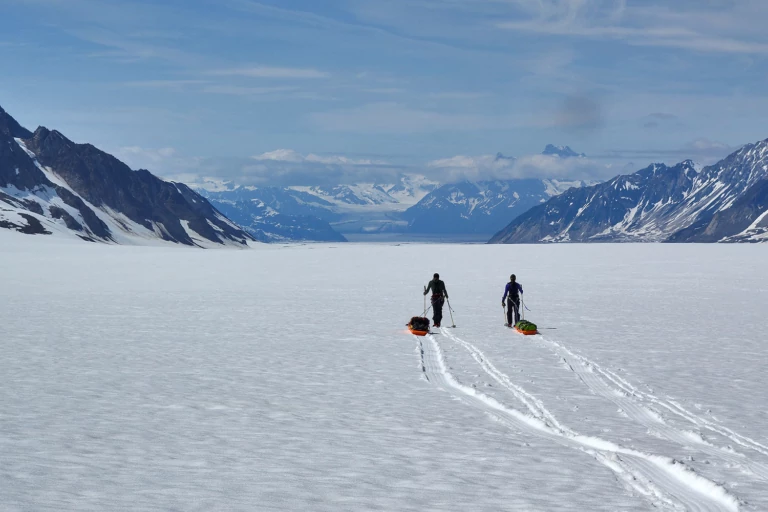
Vincent on the left and Léa and the right, enjoying the easier upper part of Miles Glacier. Childs Glacier, on the far end, is also suffering from major ice retreat. Photo: Léa Brassy
Vincent and I are looking at pristine Wrangell–St. Elias National Park in Alaska. Our plan is to cross the Miles Glacier on skis, pulling sleds, then float down the Copper River on pack rafts, following the ebb and flow of the water. Vincent crossed this glacier last year as part of a larger crossing of the entire ice cap. Nineteen days, 270 miles of one of the largest freshwater reservoirs on earth—a reservoir doomed by human activity, as its degeneration is imminent. A combination of factors, including global warming and soot deposits, are bringing glaciers like Miles under extreme threat. But what does the threat of a giant look like to a mere human being?
As with any self-supported expedition, success and enjoyment come down to meticulous preparations and attention to little details. This includes packing just enough of the necessary and reliable gear. So, we’d been happily testing our equipment before leaving France: putting up the tent in the garden while dodging Vincent’s huge dog and its swinging tail; inflating questionable-smelling mattresses while hiding from the beast; and lighting up matches on the fuel burner in summer’s steaming heat (that one worked pretty well to keep the furry animal away). However, this preparation did not save us from extensive hours of shopping once we reached Anchorage, looking for the perfect bungee cord or the strongest polypropylene rope to rig the sleds.
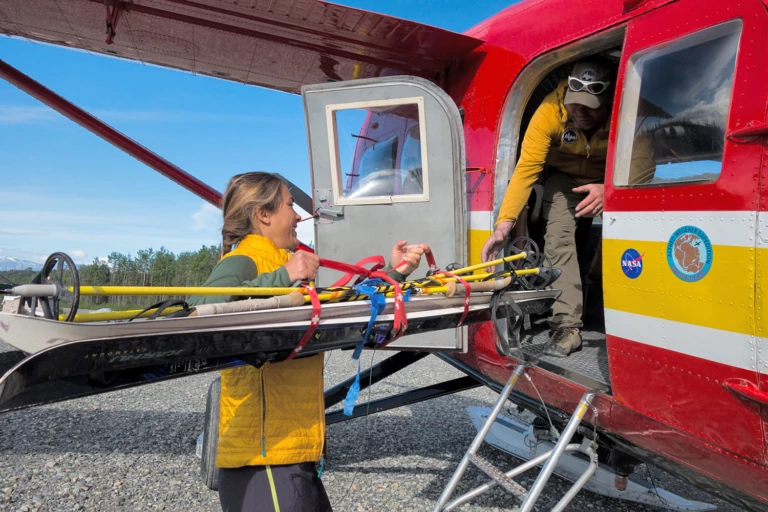
Skis and poles are loaded first in the Otter of Alaskan legendary bush pilot Paul Claus. Photo: Vincent Colliard
The adventure begins with the sight of Paul Claus’s bright red Otter bush plane at McCarthy Airstrip. Until that moment, I hadn’t believed any of this was real. Alaska is so overwhelmingly wild that I needed to physically interact with it to believe it. As we load the bush plane, my thoughts come out in an awkward blend of words, a sign of tension mixed with excitement. Headphones, seatbelt—we take off.
A few minutes later, white peaks surround us. Several times we are so close to steep blue faces I swear I could touch them. As we follow a corridor of ice, I realize that this is it! Ice wrinkles in a spectrum of greys and blues. Paul wants to know if Vincent has found a line. Vincent nods and sticks his thumbs up. We land on the most virgin snowfield. I step back to photograph the moment before Paul takes off again. I feel like I am the heroine of an old American movie, when the main characters get dropped off in the wilderness to search for bears with some cheesy music in the background. The plane flies over them to say goodbye and disappears behind the mountain, leaving them in absolute silence.
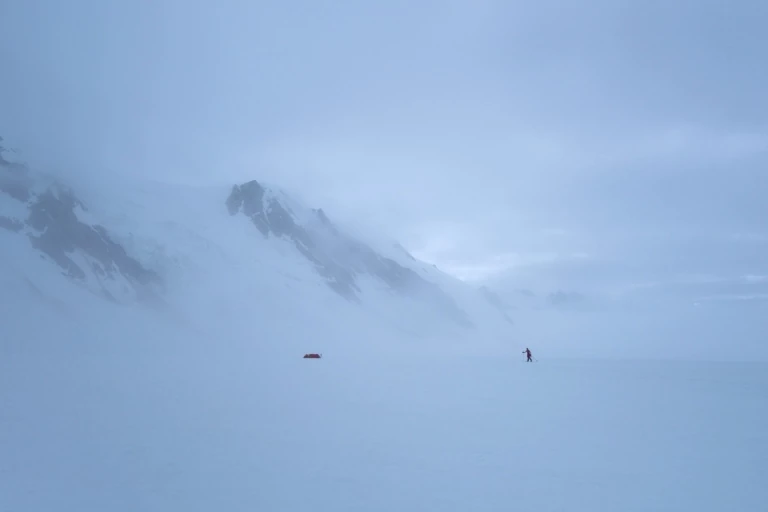
A choice occasion to set a slower pace following Nature’s rhythm. Photo: Vincent Colliard
It’s not exactly bad weather, but rather the kind of fog that encourages us to stay in the tent and take a day off, offering us the chance to acclimatize to our new routine and reset our mental rhythms to this different pace. I treasure the moment when it’s finally time to slow down. These moments are so ironically rare. Living according to nature’s rhythm might even be the real motivation behind my lifestyle. All of a sudden, simple things are so gratifying: organizing bags of gear inside the tent, making a soft pillow out of whatever’s handy, or the comfort and intimacy provided by a warm cup of tea. And only when it feels about time do I stick my head outside the tent and warm up on the skis in a total whiteout!
It’s fairly hard work to progress on the unfamiliar terrain. Skiing is not my comfort zone, especially not when it means pulling hundred-pound twin-sled setups. But I firmly believe that with my commitment I will draw closer to understanding this mesmerizing giant of ice. At first, all I notice is the sound of my breathing, the friction of my skis and the motion of my jacket. After a few days, my attention is called by surrounding sounds, such as distant rock falls echoing on the mountain faces, icefalls loudly detonating, or more subtle ice cracks closer to us. I instinctively slow down or stop when any of these happen, as if it were my own skin that was fracturing. To my surprise, the glacier is far from being still; its spirit is obvious. When rain comes into the picture, I don’t only feel the discomfort of humidity at camp—I witness the snow melting or ice eroding around each drop of water, right here underneath my skis. When the sun is out, not only do I feel my eyes squinting at the sight of the purest white landscape, I also notice ice erosion around the smallest particles of the soot or algae that are spread everywhere. It gives me perspective on how little by little, major changes occur.
Imagine the sight of a large wind swell blown by a demoniac wind, choppy surf in all directions and foamy waves frozen in motion. The ice has given up on the top and bottom of each wave, deeply cracking towards the heart of the giant. I am not asking myself anymore whether this is fun or not. I am here making progress, trying to stay safe, balancing the weight of my load and hating my heavy equipment as much as I need it. It’s late and cold, I’ve fallen hard a few times already; Vincent stays away as he knows nobody would want to cross my path right now. We call it a day when he trips on a steeper “wave” and decide to set up camp in the chaos of the ice. We’re so close to the edge from a bird’s eye view, but so far from it on our scale. In this odorless kingdom, an earthy smell tells us that we are almost done. Vast moraines, evidence of significant ice retreat, surround both sides of the glacier’s base.
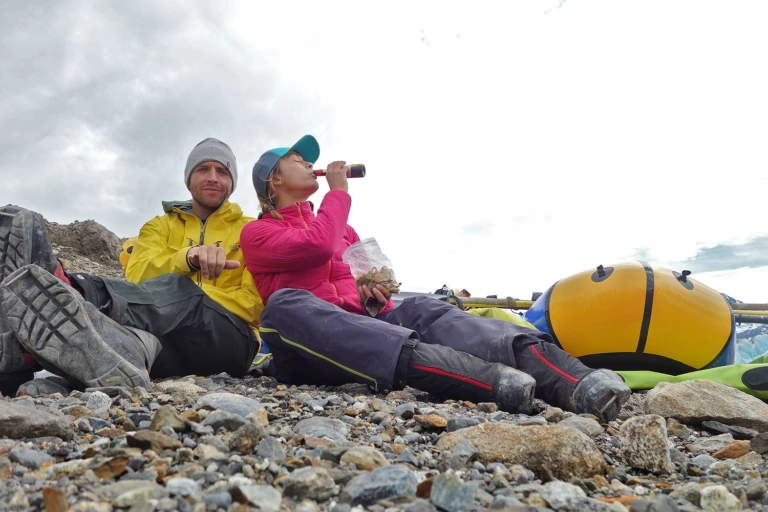
Glacier’s edge wine and shakas. Photo: Léa Brassy
We inflate two rafts by trapping air in a fabric bag. It amuses me to see how simple tricks can work so effortlessly yet efficiently. Like a jigsaw puzzle we fit and secure all our gear on the rafts; Vincent is a master of this art. Meanwhile, I cook up some black bean soup from Patagonia Provisions to fuel up before launching. We savor a little red wine we’ve saved to celebrate the transition. Ahead of us is a float down the Copper River, a journey on silky water between chunks of ice and over an invisible highway of sockeye and king salmon on their way to perpetuate their species’ survival.
Rafting down is a piece of cake. The river is giving us a tour of how lively and playful she is. We pass other glacier edges, around which we notice enormous moraines, witnessing for ourselves that calving has not happened in years. The contrast between the liveliness of the river and the shrinkage of the glaciers is telling. At this stage, no need for scientific knowledge to understand something is wrong.
Our adventure on the glacier has given me the opportunity to look at nature on a different scale, to think of the bigger picture, to widen my world. The ocean, my ultimate home, is on the doorstep of these glaciers. If they suffer, the ocean does too. These giants of ice are made of the tiniest molecules of water, and each drop matters, regardless of how salty it is.
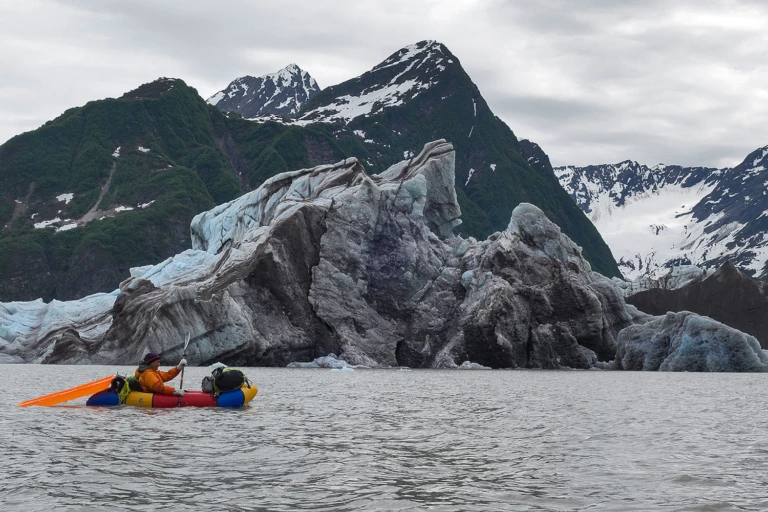
A float down the Copper River. Photo: Vincent Colliard
